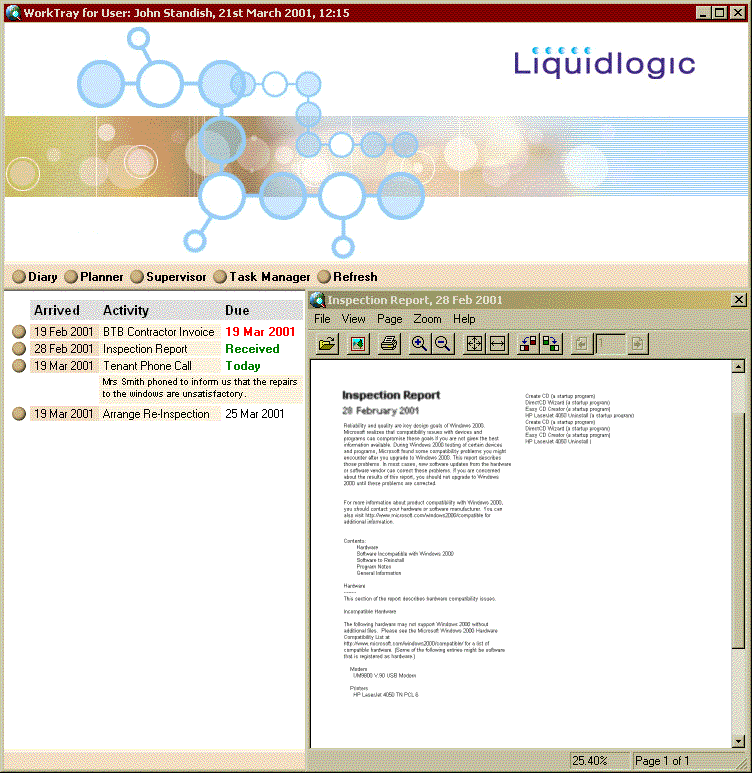 WORKFLOW
WORKS! by Denise Harrison
WORKFLOW
WORKS! by Denise Harrison WORKFLOW
WORKS! by Denise Harrison
WORKFLOW
WORKS! by Denise HarrisonIf a survey undertaken last year
is correct, workflow is high on the agenda for many housing organisations, with
a three fold increase in the number introducing workflow and it's technology
bedfellow, electronic document management (EDM), in the next 2 years. So what
is workflow, what are the benefits of its introduction and what are the pitfalls?
Quite simply, workflow is software that can automate business processes.
Workflow systems were first introduced over 20 years ago, using proprietary
equipment and with an entry cost that meant the technology could only be adopted
by cash rich organisations. Workflow was invariably used to automate and speed
up processes that were already known within the user organisation, albeit in
the heads of employees. Often, the primary purpose of these systems was to electronically
push paper images around an organisation from one department to another - hence
the common association of EDM with workflow.
During the 1990's the barriers to entry came down when systems were developed
that ran on standard PC networks and early adopters in both private and public
sectors set about introducing workflow. These early users too targeted paper
intensive activities and by the end of the decade thousands of workflow systems
were supporting numerous business processes.
Any business process uses a variety of information sources - documents, computer
data, phone calls and human decision making. Today's workflow system user will
have all the information needed to complete an item of work delivered to their
worktray - a screen based equivalent of a desk top 'in tray' (image may be a
little slow to load).

Supplier invoices - a suitable case for treatment
The process of authorising contractor invoices is a good example of a process
that lends itself to the kind of automation that workflow can provide by bringing
together salient items of information from a variety of sources and presenting
them to users and systems in a timely manner.
On detecting receipt of an invoice when it is scanned by the Accounts Department,
the workflow system routes the invoice and other relevant information, such
as purchase order details and an inspection report, to the worktray of the person
who ordered the work. This user would then check the details on screen, and,
if they were satisfied that the details were correct, would electronically authorise
the invoice for payment. The authorised invoice would then be automatically
routed back to the Accounts Department for payment and cost centre data could
be automatically transmitted to the General Ledger system. The workflow system
could monitor the overall process to ensure that all this happens within a timescale
that would ensure optimum payment arrangements - for example taking advantage
of any early settlements discounts that had been negotiated and staff performance
could be monitored in support of performance related bonuses.
The benefits
The reasons why organisations choose to implement workflow systems are well
documented
Workflow in action
One housing organisation that has enjoyed the benefits of workflow is Selby
District Council. Housing were the first department within the Authority to
scan their paper files and to let workflow distribute items of work to users
Intrays. Over 4,000 files were captured electronically allowing any user, subject
to security, to have instant access to all aspects of tenant information and
for any property, a complete history of previous tenants correspondence. Lost
files and incomplete information have become a thing of the past.
All correspondence coming into the department is scanned and automatically routed
to the appropriate staff member. In the case of staff holidays or sickness,
the workflow system can re route work to other users' Intrays ensuring that
service levels are maintained. The few items of work that cannot be automatically
routed to a specific user are sent by default to an administrator's Intray for
onward allocation. The level and throughput of work can be monitored by the
workflow system, which provides useful management information.
As with any new computer system there was some trepidation before it's introduction
and Denise Richardson, a Senior Clerk within the department, points out that
housing organisations who are intending to introduce workflow should not underestimate
the preparatory work involved in order to get the benefits. The task of preparing
files for scanning and attention to the suitability of forms for scanning, were
areas that needed careful review, but now with all information available on
line, the housing staff are pleased with their electronic environment.
Denise is enthusiastic
about the benefits for both Selby's staff and customers: "The system has saved
an awful lot of staff time and customers benefit from staff having the full
picture at their fingertips, regardless of whether the enquiry is about lettings,
repairs or rents."
Workflow in a changing environment
But is workflow the panacea for all organisational ills? What are the pitfalls?
Certainly endeavouring to 'drop' workflow on existing practices will rarely
achieve the optimum outcome. At a minimum a review of current practices is needed
and in many cases a Business Process Re engineering study will be advisable.
The introduction of workflow can be a catalyst for organisational change and,
as such it is important to ensure that the solution chosen has the capability
to support the future strategic plans for the organisation. For many years,
traditional organisations, housing organisations included, have had an all embracing
organisational model with a resource infrastructure and IT systems that supported
it. But in the 21st century, these rigid structures are being challenged and
organisations are re shaping and re grouping to support more collaborative approaches
which blur conventional boundaries.
Within the housing market, the outsourcing of activities such as Repairs, Payroll,
Accounts and IT are examples of early moves towards building new trading networks.
The invoice processing example described above could involve 3 different organisations
in the overall process, with the housing organisation linking to outside contractors
for both the repair and it's inspection. A workflow system that managed such
a trading network would need to be able to view the exact status of the process
across all these participants at any point in time.

In this example the
status within each of the organisations can be seen at a glance. The invoice
awaits authorisation and payment and the report is highlighted to draw attention
to its contents.
Future proofing your investment
Further changes, brought about by economic reality and enabled by technology,
will demand IT solutions that support collaboration and a more distributed approach.
For example, a workflow solution to Common Housing Registers could see a collaboration
of housing providers within an area, specifically for the purpose of processing
of applications for housing within that area, combining an improvement in service
for the applicant with the potential to share the administrative workload.
The UK Government enthuses about 'joined up working' and ' multi professional
teaming ' whilst the private sector talks about 'connected corporations' but
the reality is the same - successful organisations will no longer shore up their
boundaries but will operate in an environment characterised by networks of partnerships.
And as the reach of organisations extends into new partner organisations the
relevance of workflow systems takes on a new importance.
The challenge for those implementing workflow systems is to ensure the technology
approach they adopt has been designed with such considerations in mind.